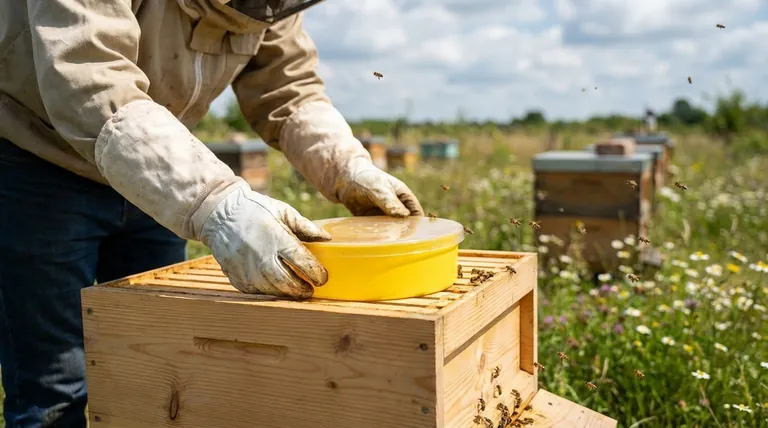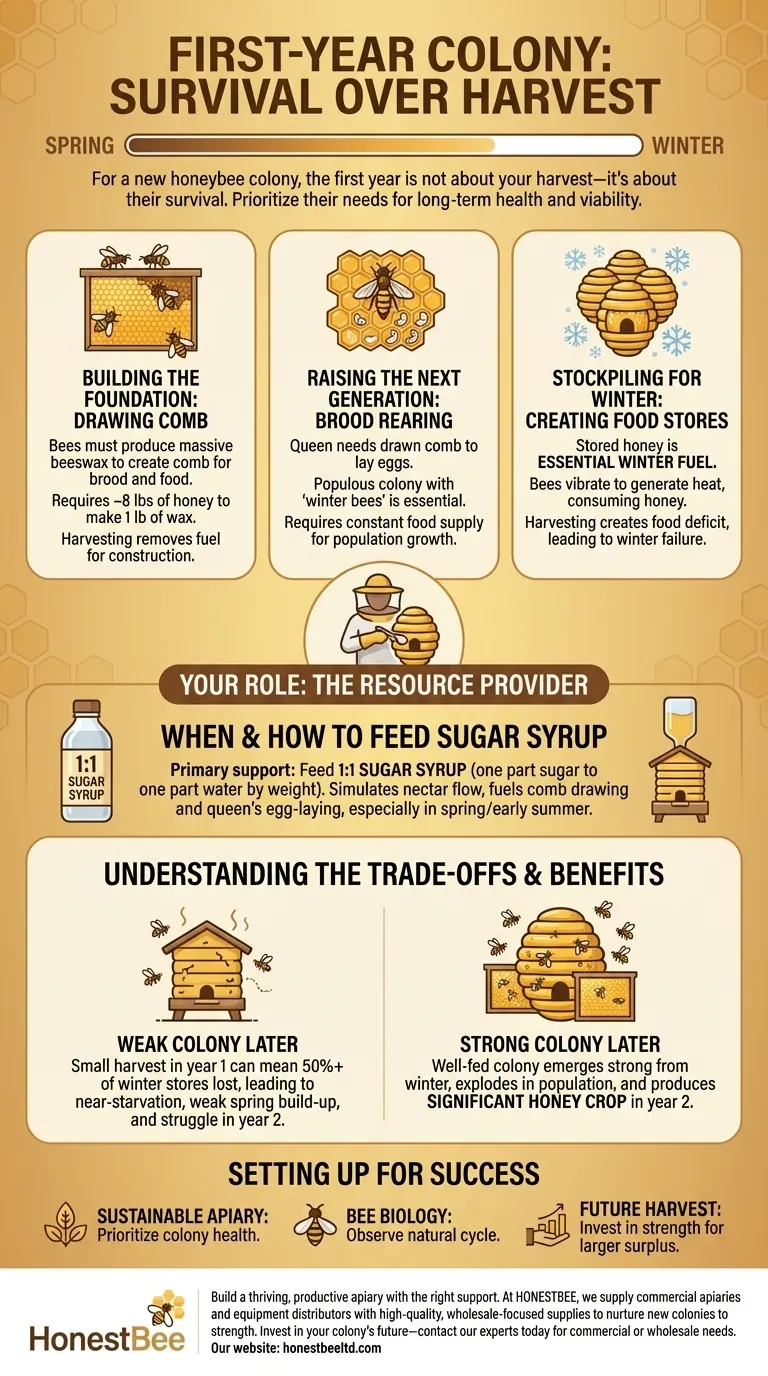For a new honeybee colony, the first year is not about your harvest—it's about their survival. Instead of taking honey, a beekeeper's primary job is to ensure the colony has more than enough food to accomplish its critical first-year tasks. This often means providing supplementary food, like sugar syrup, to fuel their development and guarantee they are strong enough to survive their first winter.
A first-year honey harvest comes at a steep price: the long-term health and viability of your colony. Prioritizing the bees' needs by supplementing their food ensures they can build the population, comb, and winter stores necessary for survival, leading to far greater returns in subsequent seasons.

The First-Year Colony's Critical Mission
A new colony, whether from a package, nuc, or swarm, is starting from behind. It faces an enormous set of tasks that must be completed before winter arrives. Your goal is to help them, not hinder them.
Building the Foundation: Drawing Comb
A new hive is mostly empty space. The bees must produce massive amounts of beeswax to draw out the comb on each frame, creating the hexagonal cells needed for raising brood and storing food.
This is an incredibly energy-intensive process. The general rule is that it takes about 8 pounds of honey (or equivalent nectar) to produce just 1 pound of wax. Taking any honey from them directly removes the fuel needed for this essential construction.
Raising the Next Generation: Brood Rearing
The queen's primary job is to lay eggs, but she can't lay them in empty air. She needs drawn-out comb.
A strong, populous colony is essential for surviving the winter. The colony must raise several generations of bees, culminating in a large population of long-lived "winter bees" that will form a cluster to stay warm. This requires a constant supply of food and available cells for the queen to lay in.
Stockpiling for Winter: Creating Food Stores
Any honey a first-year colony manages to store is not surplus; it is their essential winter fuel. During the cold months, the bee cluster generates heat by vibrating their flight muscles, and they consume honey to power this activity.
Taking this honey creates a food deficit that the colony may not be able to overcome, especially if the fall nectar flow is weak. This is the single most common reason a new colony fails to survive its first winter.
Your Role: The Resource Provider
Understanding the colony's needs redefines your role in the first year. You are not a harvester; you are a facilitator, ensuring the bees have an abundance of resources to work with.
When and How to Feed Sugar Syrup
The primary way to support a new colony is to feed them 1:1 sugar syrup (one part sugar to one part water by weight). This simulates a strong natural nectar flow.
Feeding encourages the bees to aggressively draw out comb and allows the queen to ramp up her egg-laying. This support is most critical in the spring and early summer as the colony is establishing itself.
Monitoring for Progress, Not Honey
Success in the first year is not measured in pounds of honey. Instead, your inspections should focus on key development metrics.
Look for a rapidly growing population, frames of perfectly drawn-out wax comb, and a solid pattern of eggs, larvae, and capped brood. These are the true indicators of a healthy, thriving colony that is on track for success.
Understanding the Trade-offs
It can be tempting to take just a few frames of honey, but it's crucial to understand the hidden costs of this decision.
The True Cost of a "Small" Harvest
For an established, powerful colony, a few frames of honey is a tiny fraction of their surplus. For a new colony, those same frames might represent 50% or more of their entire winter stores.
What seems like a small reward for you can create a catastrophic food shortage for the bees, forcing them into a state of near-starvation that they may not recover from.
Weak Colony Now, Weak Colony Later
A colony that is starved of resources in its first year and barely survives winter will be weak and slow to build up the following spring.
It will likely struggle through its second year as well, failing to become strong enough to produce a surplus harvest. In contrast, a well-fed colony that emerges strong from its first winter can explode in population and produce a significant honey crop in its second year.
Setting Your First-Year Colony Up for Success
Your actions in the first year directly determine the future productivity and survival of your hive. By focusing on the colony's needs, you are making a wise investment.
- If your primary focus is a sustainable, long-term apiary: Prioritize feeding and colony health over any first-year honey harvest to ensure strong, productive hives for years to come.
- If your primary focus is understanding bee biology: Use the first year to observe and support the colony's natural cycle of building comb, raising brood, and preparing for winter.
- If your primary focus is a large honey harvest (in the future): Resist the urge to take honey now, as this investment in the colony's strength will yield a much larger surplus in their second year.
By shifting your goal from extraction to support, you become the key factor in your new colony's long-term success.
Summary Table:
| First-Year Priority | Action for Beekeeper | Key Benefit to Colony |
|---|---|---|
| Comb Construction | Provide 1:1 sugar syrup | Fuels wax production for brood and food storage |
| Brood Rearing | Monitor population growth | Ensures a strong, populous colony for winter |
| Winter Preparation | Refrain from honey harvest | Guarantees adequate food stores for survival |
Build a thriving, productive apiary with the right support. At HONESTBEE, we supply commercial apiaries and beekeeping equipment distributors with the high-quality, wholesale-focused supplies needed to nurture new colonies to strength. From durable hive components to efficient feeding systems, our equipment is designed to support your bees' critical first-year development. Invest in your colony's future—contact our experts today to discuss your commercial or wholesale needs.
Visual Guide

Related Products
- HONESTBEE Round Hive Top Bee Feeder for Syrup
- Rapid Bee Feeder White Plastic 2L Round Top Feeder for 8 or 10-Frame Bee Hives
- Professional Hive Top Bee Feeder for Beekeeping
- HONESTBEE Entrance Bee Feeder Professional Hive Nutrition Solution for Beekeeping
- Classic Boardman Entrance Bee Feeder Hive Front Feeding Solution
People Also Ask
- How should syrup for bees be prepared? Master the Ratio for a Thriving Hive
- How do hive top feeders work? A Guide to Efficient, High-Capacity Bee Feeding
- What types of hive boxes is the round hive top feeder compatible with? Universal Fit for 8 & 10-Frame Langstroth Hives
- What are the features of top feeders for bees? Maximize Hive Health with Safe, High-Capacity Feeding
- What is the correct method for preparing sugar syrup for bees? Ensure Safe, Non-Toxic Feeding for Your Hives



















